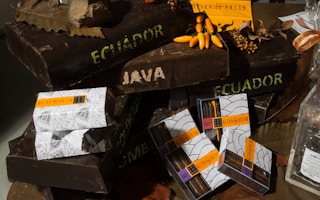Mark your calendar: January 1, 2020.
As this future year unfolds, the gap between how much cocoa the world wants to consume and how much it can produce will swell to 1 million metric tonnes, according to Mars Inc and Barry Callebaut AG, the world’s largest chocolate maker. By 2030, the predicted shortfall will grow to 2 million tonnes. And so on.
Because of disease, drought, rapacious new markets and the displacement of cacao by more-productive crops such as corn and rubber, demand is expected to outstrip supply by an additional 1 million tonnes every decade for the foreseeable future. Here, now, as you read these words, the world is running out of chocolate, Bloomberg Pursuits will report in its Holiday 2014 issue.
Last year, we again consumed more cocoa than we were able to produce. This year, despite an unexpected bumper crop, supply barely kept pace with the recent upswing in demand. From 1993 to 2007, the price of cocoa averaged $1,465 a tonne; during the subsequent six years, the average was $2,736 — an 87 per cent increase.
The world’s most universally delectable treat has begun a journey from being very loved and very common, like beer, to being very loved and a good deal less common, like Bordeaux. Unfortunately, that is the least of the confection’s problems.
Efforts are under way to make chocolate cheap and abundant — in the process inadvertently rendering it as tasteless as today’s store-bought tomatoes, yet another food, along with chicken and strawberries, that went from flavorful to forgettable on the road to plenitude.
Brave breed
Hope exists, however, in the form of a brave new breed of cacao, engineered to be not just fecund and disease-free but also flavorful. This emerging supervariety promises the world a steady supply of high-quality chocolate — and perhaps holds the key to how all future food should be grown.
In the far north of Costa Rica, just outside the town of Upala, stands a field that should unsettle anyone who enjoys chocolate. The view there is of corn — as far as the eye can see. The stalks aren’t as military-formation perfect as in Nebraska, but the crop is as thick as they come. Farther down the road, there are dairy cows grazing on pastureland, soaring plantations of hardwood trees and fields of cassava. Every few kilometers, there is a pineapple farm; at least once an hour, it seems, a fruit-laden truck comes whining down the road.
The one crop you won’t see is cacao, the tree whose seeds are fermented and roasted to become cocoa. Cacao used to be big here. At one time, it grew so thick there were no dairy cows or pineapples. Miguel Orozco used to raise it on this 12-hectare (30-acre) plot planted by his grandfather, and it earned him enough money to send all seven of his children to college or university.
Frosty pod
In 1978, a fungal disease called frosty pod was found on cacao pods along Costa Rica’s Caribbean coast. A year later, the disease had made its way inland, and before long, two of Orozco’s sons found pods on their plantation blighted with brown lesions covered in a white, cottony powder.
For 10 years, the Orozco family waged war on frosty pod. They covered the diseased pods in oil, buried them in large pits and burned them. Eventually, there were too many rotten pods to burn, and a little more than a decade after the disease had first been discovered, Orozco and his sons took a chain saw to every cacao tree until all dozen hectares had been cleared. The family’s annual harvest of 12,000 kilograms (26,000 pounds) of high-quality cocoa beans — enough for more than 600,000 1.5-ounce bars of milk chocolate — was gone.
Exhaustible resource
Chocolate lovers rarely pause to consider that cocoa might be an exhaustible resource. Those who do generally assume that the biggest threat is climate change, which is indeed expected to have severe negative consequences.
According to a report prepared by the International Center for Tropical Agriculture for the Bill & Melinda Gates Foundation, in Ghana and Ivory Coast — which together produce 53 per cent of the world’s cocoa — temperatures will increase by up to 2 degrees Celsius (3.6 degrees Fahrenheit) by 2050, intensifying the dry season and causing water shortages. The result, the report states, is that “cocoa-growing areas will decrease seriously.”
However catastrophic, the threat of drought pales in comparison with that of disease. Frosty pod colonized Costa Rica in just two years. Witches’ broom, another devastating fungus, in 1989 infiltrated the Brazilian state of Bahia, a cocoa-producing powerhouse whose yield subsequently collapsed, falling by more than half, from 300,000 tons to 130,000 tons annually, in a decade.
To continue reading the rest of the story, click here.










